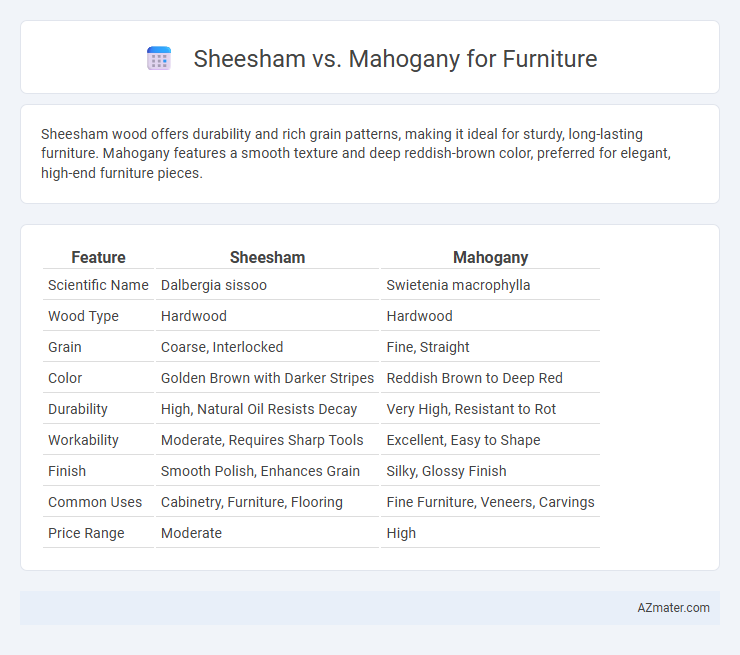Sheesham wood offers durability and rich grain patterns, making it ideal for sturdy, long-lasting furniture. Mahogany features a smooth texture and deep reddish-brown color, preferred for elegant, high-end furniture pieces.
Table of Comparison
| Feature | Sheesham | Mahogany |
|---|---|---|
| Scientific Name | Dalbergia sissoo | Swietenia macrophylla |
| Wood Type | Hardwood | Hardwood |
| Grain | Coarse, Interlocked | Fine, Straight |
| Color | Golden Brown with Darker Stripes | Reddish Brown to Deep Red |
| Durability | High, Natural Oil Resists Decay | Very High, Resistant to Rot |
| Workability | Moderate, Requires Sharp Tools | Excellent, Easy to Shape |
| Finish | Smooth Polish, Enhances Grain | Silky, Glossy Finish |
| Common Uses | Cabinetry, Furniture, Flooring | Fine Furniture, Veneers, Carvings |
| Price Range | Moderate | High |
Introduction to Sheesham and Mahogany Wood
Sheesham wood, also known as Indian Rosewood, is prized for its durability, rich grain patterns, and natural resistance to decay, making it a popular choice for furniture crafting. Mahogany wood is renowned for its deep reddish-brown color, fine grain, and strength, offering an elegant and timeless appeal in high-end furniture design. Both woods provide exceptional sturdiness and aesthetic qualities, yet Sheesham tends to be more affordable while Mahogany is often preferred for luxury furniture pieces.
Origins and Botanical Classification
Sheesham, scientifically known as Dalbergia sissoo, is native to the Indian subcontinent and belongs to the Fabaceae family, prized for its hardwood durability in furniture making. Mahogany, from the genus Swietenia in the Meliaceae family, originates primarily from Central and South America, renowned for its rich, reddish-brown color and fine grain texture. Both woods offer unique botanical traits influencing their strength and aesthetic appeal, with Sheesham growing as a fast-growing deciduous tree and Mahogany classified as a slower-growing tropical hardwood.
Physical Appearance and Color Variations
Sheesham wood features a rich, golden-brown hue with distinctive dark grain patterns, offering a warm and natural aesthetic ideal for traditional and rustic furniture designs. Mahogany presents a deep reddish-brown color with a smooth, fine grain that darkens over time, providing an elegant and classic appearance favored in high-end furniture. Both woods showcase unique color variations, with Sheesham displaying more contrast and texture, while Mahogany offers uniformity and a glossy finish, influencing their selection based on desired visual impact.
Durability and Longevity Comparison
Sheesham wood, known for its dense grain and natural resistance to decay, offers exceptional durability ideal for heavy-use furniture, while mahogany provides a slightly softer texture but maintains impressive strength and longevity through its natural oils that combat moisture and pests. Both woods resist warping and cracking, yet Sheesham's harder composition ensures greater wear resistance over time. Mahogany's stability and fine finish make it equally long-lasting, but Sheesham's robustness often results in a longer service life in high-traffic environments.
Workability and Crafting Ease
Sheesham wood offers excellent workability due to its medium hardness and natural oils, making it easy to cut, carve, and polish for intricate furniture designs. Mahogany is prized for its uniform texture and straight grain, facilitating smooth shaping and sanding, which enhances crafting precision and finish quality. Both woods respond well to hand and machine tools, but Sheesham's density provides superior durability while Mahogany ensures a rich, fine surface ideal for high-end furniture.
Resistance to Pests and Decay
Sheesham wood, also known as Indian rosewood, exhibits strong natural resistance to pests and decay due to its dense grain and natural oils, making it highly durable for furniture in humid climates. Mahogany, prized for its stability and rich color, offers moderate resistance to pests and decay but typically requires treatment or finishing to enhance its longevity in environments prone to moisture and insects. When selecting furniture wood based on resistance, Sheesham is generally preferred for outdoor or high-moisture settings, while Mahogany suits indoor furniture where conditions are more controlled.
Cost and Market Availability
Sheesham wood is generally more affordable and widely available in South Asian markets due to its local abundance, making it a cost-effective choice for furniture. Mahogany, prized for its rich color and durability, tends to be more expensive and less readily available, with supply often limited to specialized hardwood vendors or imports. The price difference reflects the rarity and finish quality, with mahogany furniture positioned as a premium option compared to the more budget-friendly sheesham pieces.
Environmental Impact and Sustainability
Sheesham wood, sourced primarily from India, is known for its rapid growth and sustainable harvesting practices, making it a more eco-friendly option compared to mahogany. Mahogany, often derived from slower-growing tropical hardwood trees, faces concerns over deforestation and habitat loss due to less regulated logging in some regions. Choosing Sheesham supports sustainable forestry efforts while reducing the environmental footprint of furniture production.
Best Uses in Furniture Design
Sheesham wood excels in intricate carvings and traditional furniture due to its dense grain and natural luster, making it ideal for ornate cabinets, bed frames, and decorative pieces. Mahogany is favored for high-end furniture and classic designs because of its rich reddish-brown hue and smooth finish, perfect for elegant dining tables, chairs, and veneer work. Both woods offer durability, but Sheesham suits rustic, handcrafted aesthetics while Mahogany aligns with polished, luxurious interiors.
Final Verdict: Which Wood is Better for Furniture?
Sheesham wood offers exceptional durability and rich grain patterns, making it ideal for traditional furniture with a warm, rustic appeal. Mahogany is prized for its smooth texture, deep reddish-brown color, and superior resistance to decay, often used in high-end, elegant designs. Choosing between Sheesham and Mahogany depends on desired aesthetics and budget, with Mahogany favored for luxury pieces and Sheesham for cost-effective, durable furniture.

Infographic: Sheesham vs Mahogany for Furniture
 azmater.com
azmater.com